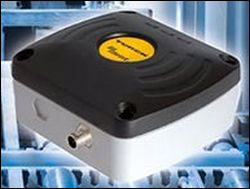Factory automation equipment company Turck USA‘s new Q120 compact EPC ultrahigh-frequency (UHF) RFID reader and integrated antenna is being trialed by 12 companies—textile and drug manufacturers, as well as automobile companies and food and beverage makers—for tracking tagged items at a close range of 3 meters (9.8 feet) or less. The reader, announced at the RFID Journal LIVE! 2014 conference and exhibition, held last week in Orlando, Fla., is an alternative to the company’s previously released Q175 reader used as part of Turck’s BL ident RFID system for tracking goods within a manufacturing environment. The firm’s RFID hardware is being used primarily by pharmaceutical, automotive, and food and beverage companies to manage work-in-progress or track inventory as parts move through the assembly process.
Turck USA, a division of German firm Turck, markets its BL ident technology (consisting of RFID tags, software and IP67-rated readers) to manufacturers for use in extreme conditions, says Matt Boudjouk, Turck RFID’s product manager, such as very high or low temperatures, a high presence of chemicals or other liquids, or the presence of dust, dirt and grease. The tags are typically attached to automotive parts or other items, so that they can be tracked while moving through the facility with the goal of improving inventory management, as well as monitoring work-in-progress as components are assembled.

Many of Turck’s customers are using a high-frequency (HF) version of the BL ident system, in which tags are read at very close range, such as at specific locations on a conveyor during assembly. Some of those customers are transitioning from HF to UHF technology, Boudjouk says, but as they do so, they might not require the long read range typically provided by UHF. The Q175, for example, has a read range of approximately 6 meters (19.7 feet). In some cases, the read range was too long, leading to stray reads from other tags within the vicinity. Therefore, Turck began developing a new short-range reader that can fit into small spaces—and, at $1,800, costs about $400 less than its larger predecessor.
Some of Turck’s customers are now testing the Q120 reader, installing the device along conveyor belts, for example, so that the tags of items on the belt are interrogated only as they near the reader, while those attached to other items are not. For instance, if a box filled with tagged containers of drugs passed a reader on a conveyor, the Q120 would read only the tags in the box immediately beside it, rather than those in other boxes further ahead or behind it on the line.
The new reader features an IP67-rated aluminum housing that measures 130 millimeters by 120 millimeters by 60 millimeters (5.1 inches by 4.7 inches by 2.4 inches). Like other Turck products, Boudjouk says, it is designed to operate under extreme conditions, such as the temperatures present in autoclaves or paint shops.
“The Q120 offers another alternative to our customers,” Boudjouk states. Because the reader is small, he adds, it can be mounted in areas where the larger version could not fit, thereby potentially providing greater protection to the reader itself from potential damage caused by, for example, automated moving parts.
The reader operates with all standard EPC UHF RFID tags, including those manufactured by Turck. Once it interrogates a tag, the device forwards that data via a cabled connection to the BL ident back-end software, which stores and interprets the collected read data, as well as triggers responses based on that information, such as issuing an alert or encoding additional data to tags. In 2015, a next-generation version of the Q120 is expected to be able to store read data in the event of, for instance, a network outage.


